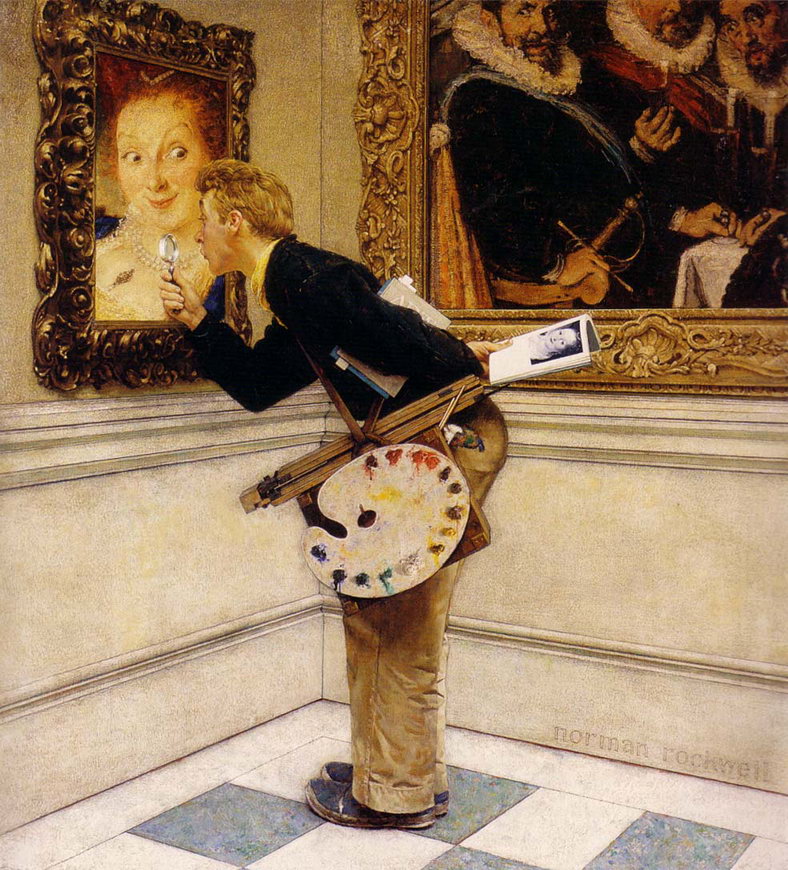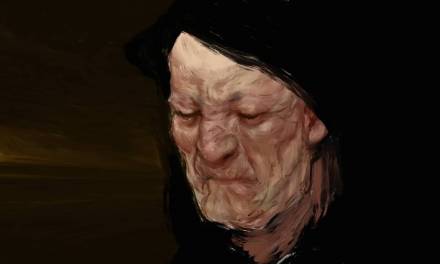Inner Demons – 2016
This is a subject that is probably very familiar to you as an artist, and though I don’t think creatives are special in that we feel guilt more than others, I do think it’s especially difficult in the sense that we’ve chosen a passion that ties our hearts and souls directly to our work in such a vulnerable way, and yet, somehow, we expect (from ourselves) to remain unscathed in the process.
There are three general ways to categorize different levels of guilt and shame, according to the National Institute for the Clinical Application of Behavior Medicine:
1. Helpful Guilt (healthy)
2. Unhelpful Guilt (unhealthy)
3. Shame (very unhealthy)
1. Helpful guilt is often the result of an objective wrong we have committed, whether intentional or unintentional. If handled correctly, the outcome can be positive and allow for healing from all parties.
2. Unhelpful guilt is when we break unrealistically high standards, often ones we have set for ourselves (sound familiar?). The only outcome of this type of unhealthy guilt is negative. While helpful guilt can help you grow as a person and heal from mistakes, unhealthy guilt only traps you in a cycle of self-punishment.
3. Shame is when we feel worthless as a human, and undeserving of love and self-compassion. This only ever has a negative consequence and is the most detrimental of all.
One of my favorite researchers and authors, Brené Brown, said this about shame:
“Shame is a focus on self,
guilt is a focus on behavior.
Shame is ‘I am bad.’
Guilt is ‘I did something bad.’”
It is important to note that an excessive level of guilt or shame can be a symptom of a possible mental health condition. Please talk to a medical health professional if you suspect you may fall into this category; you’d be surprised how many of people do. Medication made such a huge difference with how pervasively I felt guilt in my everyday life; it may make the biggest difference of all for you as well.
Common Feelings of Guilt
There are two general categories of the familiar guilty feelings we’ve had as artists (and non-artists alike): one, “I’m not doing enough” which relates to our actions, and two, “I’m not good enough” which relates to our sense of self-worth. These groups are actually directly related to each other; not doing enough is a result of not feeling good enough if you fail to do enough, but we’ll talk about that later. For now, let’s go into each category:
I’m Not Doing Enough
- “I’m not working hard enough”
- “I’m not spending enough time working”
- “I’m not posting on social media enough”
- “I’m posting on social media too much”
- “I’m not making enough personal work”
- “I’m making too much personal work, I need to be doing more work that makes an income”
- “I’m not making enough money”
- etc. etc. etc.
Have you thought any of these things before? (we all have at some point!) All of these thoughts can be boiled down to “I’m not doing enough.” It’s all about output, productivity, and hustle culture, which is toxic and prevalent in our society, even in our own niche art industry. We romanticize busyness, thinking we are more valuable as artists when we are swamped with work, and less valuable as artists when we find our schedules open. If we stop doing something, even for a minute of rest, the guilt starts to settle in, nudging and poking and prying at you until you get up and get back to work. So you sit down and start working, only to feel that guilt prodding you again, reminding you that you need to take better care of yourself and make sure you’re relaxing enough.
As far as the guilt is concerned, nothing is ever enough.
Our own expectations are often unreachable and impossible. Our standards are impossibly high, then we beat ourselves up for not being able to reach them. We tell ourselves that everyone else can do this, why is this so hard for us?
“I’m not working hard enough” – what does that mean? What does working “hard enough” actually look like? Is it 4 hours a day? 8? 2? Is it a quantity thing (hours in the day) or a quality thing (focusing your energy on completing specific tasks)?
We imagine the feelings of guilt will disappear once we reach those hours we set for ourselves, but the goal posts shift again and again, so those familiar awful feelings return. It’s no wonder we constantly feel bad that we aren’t doing enough, because what we think is enough is actually impossible.
We’ll address some ways you can cope with this type of guilt later on, after we talk about the next category of guilty feelings:
I’m Not Good Enough
(i.e. Shame)
- “I’m not painting or drawing the right way” (i.e. tracing, photobashing, too fast or too slow, etc.) >>> I’m a fraud
- “Art is self-indulgent and impractical” >>> I am selfish for chosing this career
- “I feel privileged to be able to do this as a career, yet guilty that I don’t love it all the time” >>> I should be grateful, other people have it worse (a true fact, but an unhelpful thought process for healing and recovery purposes)
- “I should have gotten a real job” >>> I’m irresponsible
- “I’m not a good parent, caretaker, friend, etc.” >>> I’m a bad person
These types of feelings are connected directly with shame. We feel that we must be fraudulent if we are tracing at any point in the process, therefore we are only authentic and genuine artists if we don’t trace. We feel that art is somewhat self-indulgent, therefore we are self-indulgent for choosing this type of career. When you get to the root of it and dig as deep as you can go, it’s usually an irrational but powerful thought process of tying our worth as humans to not being good enough, for others, but also, and more importantly, for ourselves.
The process looks like this:
When I am:
Productive
I feel:
I am a good artist
Therefore:
I am worthwhile
When you believe these statements, it means you also believe the opposite:
When I am:
Unproductive
I feel:
I am a bad artist
Therefore:
I am worthless
You can’t believe one half of the equation and not the other, they go hand in hand. If you believe, deep down, that your worth is tied to your work and your productivity, you also believe you are worthless when you aren’t able to reach your work and productivity standards, which are often impossible to reach in the first place. It’s no wonder the guilt feels like a never-ending cycle!
The good news is there are things we can do to address our guilt and replace it with more helpful feelings.
Consume – 2014
How to Overcome Guilt
It’s important to remember that you can’t simply decide not to feel a certain way anymore. Our thoughts are too persistent and we are creatures of habit, falling back to what is familiar, even if the familiar makes us feel bad. Instead of thinking “I shouldn’t feel guilty about this” (as if you need the added pressure of feeling guilty about feeling too much guilt, hah), we’re going to walk through a process that will allow you to move through the feeling and emerge on the other end, instead of being caught in an endless cycle. It allows you to process your feelings in a healthy way and grow from them.
1
Name It
The first step is to name your feeling of guilt. Say it. Speak it out loud, literally. Say it to yourself as you’re sitting here, reading this. It could be “I feel guilty that I’m sitting on my phone reading this when I should be writing emails” or “I feel guilty that I’m not sleeping and instead I’m staying up late on my computer reading this.” The reason why it’s important to name your guilt is because the minute you speak your thought process out loud, it loses a little bit of its power.
Before you name it, it’s intangible, floating around in your brain, an ethereal ghost constantly haunting you. When you speak your guilty thought out loud, you immediately put boundaries around it, you take this omniscient, immortal thing and suddenly concretize it. It’s now mortal and solid, which then makes it beatable.
The scariest movies never show the monster, because the most horrific things live inside our imagination. As soon as we see the entire creature on the screen, it loses some of that horror. It’s the same principle: we want to solidify our thoughts so we can move onto the next part of the process:
2
Observe It
So you’ve named your guilty thought out loud. Awesome. The next step is to change how you think about that thought. Instead of feeling it, as if its a part of you, I want you to observe it. Pretend you are a passerby and you see this guilty thought. Look at it with curiosity and not with judgement or blame. It looks something like this: “Huh, that’s interesting, I feel guilty that I’m sitting on my phone reading this, when I think I should be writing emails instead. I’m curious how that thought got there.”
Doing this helps to take away the shame and judgemental tone in which our inner voices so often speak, so it separates the action/guilty feeling from our sense of self-worth. It makes it objective instead of subjective.
3
Analyze It
Now that you are viewing the world through curious and non-judgemental eyes, and you’ve made an interesting observation about the guilt-centered thought, now you need to get down to the root of that thought. This is pretty easy: whenever you make a statement, simply ask “Why?” after each observation. For example:
“I feel guilty that I’m sitting on my phone reading this article when I should be writing emails.”
“Huh, that’s really interesting, WHY do I feel I should be writing emails instead of reading this article.”
“I feel I should be writing emails because I have some waiting for me and I should write them back.”
“Ok interesting, WHY is that important?”
“Because good artists write emails back quickly.”
“WHY is that so?”
“Because good artists are productive.”
“WHY is that important??”
“Because being productive means you’re a good person, which means I am a bad person if I’m not being productive.”
So you eventually get down to the problematic belief at the heart of it all: productivity = good human, therefore, unproductivity = bad human, essentially. You can do this with any thought process of course, it usually boils down to some similar irrational deeply-held belief, maybe even beliefs you weren’t aware you had. So just keep asking yourself WHY, and you’ll find the answers you need. It’s important for you to be honest with yourself in order for this step to be effective.
Here are a few general other tips you can apply to your life to move through guilt and weaken its power.
4
Compartmentalize Your Life
Besides naming it, observing it, and analyzing it, another incredibly helpful method is to compartmentalize the various areas of your life, as best as you reasonably can.
I work from home and have two younger kids. When they were really little and not in school or daycare, I worked right next to them while they played and fought and yelled and laughed. I thought it would be easy to go back and forth, that I could help them and draw a bit and give them a snack and draw a bit more and it would be easy.
I was wrong. I was very, very wrong.
Having to work while being frequently interrupted is a recipe for disaster. I was stressed from not getting work done, from not being able to play with them more often, about splitting my time between work and family constantly, always feeling like I wasn’t giving enough to everyone. When I was being a “good” mom (what I thought was a good mom), i.e. making homemade dinner, playing with them, going to the park, etc., I was not being a good artist; i.e. deadlines getting closer, trying to cram in work, not making time for personal work, feeling burnt out, and visa versa. When I was meeting my deadlines early and wrapping up covers, my kids watched more movies and ate more mac and cheese for dinner. My problem was I thought good mom = home-cooked meals, no screen time, lots of outside play. When I felt that way, it meant the opposite must be true: bad mom = lots of movies, boxed dinners, more time spent inside.
So, I divided my family and work life as much as I possibly could. I stopped trying to work during the day and saved all my work until night, when I could somewhat reliably work uninterrupted. It was only anywhere from 1 – 3 hours of work most nights, but it was something. I moved my desk to a designated area and blocked it off as much as I could. I still felt bad during the day if I had a deadline, but it was MUCH much better than before.
I also separated my thoughts of what I thought made me a good parent, from what actually made me a good parent. When I came to terms that whether I was a good parent had nothing to do with how much screen time they had, or what they ate for dinner occasionally, and it had more to do with love and attention and making sure we knew we loved them, it helped a lot, so I wasn’t feeling a constant sense of guilt. I knew, if I did just a few simple, important things with my kids, I was a good parent, and I was no longer reliant on some arbitrary checklist to determine my status as such.
I do realize that a lot of compartmentalizing comes down to how much privilege you have in your life, as well as what season of life you’re in. Asking a new parent to have “baby time” and “work time” is a joke. It’s yet another impossible goal. The same goes for telling someone they just need to find a nanny or put their kid in daycare; it’s much easier said than done and isn’t accessible to many people and/or is unrealistic. So if you find yourself in this type of situation, do what you can to make it work, but don’t beat yourself up if it isn’t your ideal situation yet. My resolution to the problem in the early years was far from perfect, it wasn’t the ideal situation (comparing my 1-3 hours of work every night to others 8 hours was NOT good for my mental health), but it was better than feeling stressed constantly.
5
Schedule Time to Relax
We’ve all been there: you sit down to scroll on your phone or watch a movie and you find you can’t actually enjoy the downtime because you feel bad about not working. So, not only do you not feel rested, but guilty on top of it. If you take the time to be intentional about how you use your free time, the guilt will go away over time, and you’ll find that your downtime is restful and sufficient. In practice, you designate a certain time of day for your downtime (like 12:30-1:30) or you give yourself an amount of time, like an hour or two. When you do this, the guilt tries to remind you of what you “should” be doing, but you know you’ll be working again when the time is up, so there’s nothing for the guilt to fight against, and eventually, the voice quiets down and leaves you alone.
It can be hard to do this in application, especially when you’re first trying it out, not because it’s difficult to accomplish but because of the discipline it requires. It’s like any habit, it’s hard to develop in the beginning, but over time it gets easier, until it becomes second nature. Trust the process, it WILL get easier eventually.
6
Self-Compassion
Giving ourselves self-compassion is probably the hardest step of all. We are so quick to give others the benefit of the doubt, to accept their best as it is and be proud of them for trying, to support them and love them and want them to be happy. It’s easy to feel this way about others, but when we turn it back to ourselves, we suddenly have all these reasons why it doesn’t apply to us.
“We should have known better!”
“I don’t deserve grace and understanding.”
“I shouldn’t make mistakes.”
Should and shouldn’t are some of the most unhelpful words we can use when we try and defend ourselves. All the shoulds in the world don’t really matter. We tell ourselves we are different and undeserving of the empathy and compassion we give to others so freely. The hardest part is realizing, deep down, that you DO deserve self-compassion. You deserve self-love, whether you paint 2 hours a day, or 12 hours a day, or none at all. You deserve to be imperfect and whole and complete, even when you make mistakes, very human mistakes that everyone else in the world makes. You deserve to know that you are a good person and a worthwhile human, unconditionally.
. . .
Maybe it’s been a long time since you could draw. Maybe you are going through a family crisis. Maybe you’re living through a global pandemic and you’re overwhelmed and struggling to survive on a daily basis. On top of all this, you feel guilty that you aren’t drawing or can’t draw or aren’t doing it right or enough or too much.
Our feelings are meant to serve us. To help and guide us. To point us in a direction. If they get to a point where they’re unhealthy and no longer serving us, then we need to face and process our feelings, with compassion and understanding, recognize that we’re human, and move forward with our new-found sense of empathy and growth.
. . .
If you’re interested in learning more about this topic, I highly recommend checking out the links below:
TED Talk: Listening to Shame by Brené Brown
A fantastic post here on Muddy Colors by Tommy Arnold about the myth of the work/life balance: If You Just Want to Work, That’s OK
Another great article on Muddy Colors by Lauren Panepinto, specifically about productivity during the pandemic, but applicable to our relationship with productivity and rest in general: Pandemic Productivity
Please remember to take care of yourself!
– Miranda










Thank you, Miranda.
Thank you so much for writing this. It definitely resonates. My husband often points out that I’m really good at being compassionate towards others and then set unrealistic expectations for myself.
Wonderful article Miranda, thank you so much for writing this. Lots of great food for thought.